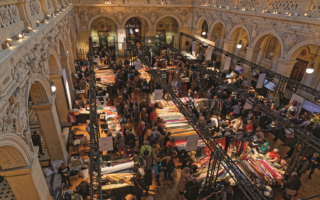From Cap to Cap
Walking the Cap Martin coast path to Cap d’Ail exposes Tristan Rutherford to the delicious sights, smells and tastes of the Côte d’Azur
It’s pain-au-choc-o’clock in the sunniest corner of France. But on the polyglot peninsulas of the Cote d’Azur, cosmopolitanism is in the air. Cap Martin and Cap d’Ail are mere miles from Italy and Monaco. My biere’n’boules café sells cioccolato gelato and frutti di mare. The local traffic warden is trilingual. He will post your parking fine anywhere in the EU.
Decades ago such diversity attracted Swiss architects, Swedish film stars and Spanish painters. All were recently honoured by two grand cultural openings, plus a new feature film. It’s a four-hour, 14-kilometre hike to hit these cultural caps in a single day. I gulp my macchiato and call merci to le patron. It’s time to move on.
A bust of architect extraordinaire Le Corbusier marks the trailhead around Cap Martin. A signpost indicates his Cabanon beach house (45 minutes on foot) which reopens to the public this month. It’s an Edenic hike there. The path has a fragrant aroma of rosemary, orange blossom and umbrella pine. To the left, an open seascape to Italy shimmers in the morning sun. The path bends and bumps above a swimming pool sea until Monaco comes into view. But the plastic-fantastic Principality appears as a carbuncle on the coast. Le Corbusier would be appalled.
The proof of this can be found in the Cabanon. Set just below the Cap Martin coastal trail, this log cabin is a lesson in South of France simplicity. His modernist methodology decreed that modular beach bliss could be squeezed into less than 14 square metres. Allegedly, it only took the Swiss genius 45 minutes to sketch the design for the cabin in the winter of 1949. At just 3.66 metres by 3.66 metres, his cuboid holiday home proves that happy habitation can also come at a minimal cost. Although the olive-shaded location above a sandy-bottomed cove certainly helps.
Just beside the Cabanon, Le Corbusier designed five Unités de Camping. At just eight square metres each, these ‘holiday units’ were a futuristic vision of French tourism. They also reopens for visitors this month. Inside, wooden boxes pivot to make beds and chairs. Slats open to allow cross ventilation. Window blinds double as shaving mirrors. It’s an homage to his famous l’Unité d’Habitation building block in Marseille – in miniature.
Alas, Le Corbusier wasn’t the first architect to bring modernism to Cap Martin. That title belongs to Irish designer Eileen Gray, whose Villa E-1027 was built alongside the coastal path decades before. Here I meet Michael Likierman, the man who spearheaded the renovation of these unique cultural spaces (Villa E-1027 reopened this May), for a look around.
Gray’s 1929 creation is a vast white rectangle. Yet it’s somehow perfectly congruous with its setting of green olives, raging lilac and azure sea. Likierman shows me the futuristic functionality inside. The world’s first sliding blinds open onto a panoramic seascape. Art deco swoops and swirls hide cabinets and drawers. A ‘bronzing chamber’ solarium is fashioned from black ‘tan-fast’ tiles.
Likierman explains Le Corbusier’s subsequent fascination with Gray. “She was a fabulous member of les années folles, and much courted for designing elegant apartments in Paris, before she decided to build a villa for herself by the sea.” The Swiss rented the Irishwoman’s Cap Martin villa in the late 1930s. The fascination turned into jealousy, however. There was a sense that the unassuming Gray had pipped him to the modernist post. In 1938 Le Corbusier daubed stunning – if inappropriate – frescoes on Grey’s clean pastel walls. According to The Guardian: “He asserted his dominion, like a urinating dog, over the territory. Gray saw his painting as a violation and was furious.” Gray never entered her house again. Le Corbusier died in 1965 while swimming below the villa and is buried nearby. Gray passed away in 1975 and was laid to rest in Paris’ Père Lachaise.
“It was such a drama that they turned the story into a film,” says Likierman. He assisted with the recent Cap Martin filming of The Price of Desire, which traces Gray’s tumultuous relationship with Le Corbusier. Likierman also attended the premiere at the 2015 Dublin Film Festival. “In Ireland she is now worshipped as the greatest Irish designer.” The Irish Ambassador to France travelled to Cap Martin to attend the reopening of these cultural venues associated with Gray and Le Corbusier.
From here to the Monaco border, some 40 minutes away on foot, the trail hits its beachiest reach. Every step is a pine-trees-blue-seas-ocean-breeze extravaganza. Steps lead down to Plage de Buse, a white arc of public sand, and Plage du Golfe Bleu, an ever longer sandy curve just beyond. It’s a choice between heaven, and heaven plus one. Parascenders – who take a leap of faith from the grand corniche clifftops high above – descend like angels to the Golfe Bleu beach. This section of the path is known as the Sentier des Douaniers. Customs officials once patrolled this coast to guard against cigarette smuggling to Italy, and, rather more healthily, contraband olive oil coming in the other direction.
I pause to buy a pan bagnat (a salade Niçoise in a bun) at Roquebrune-Cap-Martin’s little station. (Likierman and team are refurbishing the unused sidings into another cultural space, due to open in stages until 2017.) I’m keen to lunch in peace so I trot on along the path. Beaches become coves, and coves become nameless creeks, until I find four square metres of shingle beside Monaco for a snack/siesta/swim. I need it, as my coastal walk is only half done.
Like a fool, I choose to hike the four kilometres across Monaco (non-masochists can take the No 6 bus across the country for just €2). The Principality’s reclaimed seaside suburb of Fontvieille abuts the French border. Surprisingly it hosts an ‘international airport’, where scheduled seven-minute helicopter shuttles to Nice Airport depart every 15 minutes. Such exuberance created the glorious French suburb of Cap d’Ail next door. I cross the street into France to find out more.
The final three and a half kilometres of coastal path from the beaches of Plage Marquet to Plage Mala weren’t built for les douaniers. Oh no. The route was generously provided by Monaco’s Société des Bains de Mer – the company that owns the Casino de Monte-Carlo – to provide highrollers with a scenic route to the Baccarat tables. Information boards explain the Monégasque provenance of the rococo mansions that line the route. Villa The Rock was frequented by Greto Garbo after partying in the Principality. La Capponcina, just above the path, was owned by Lord Beaverbrook and hosted casino lover Winston Churchill. Various mansions were used as seaside escapes by Princess Grace when she fled the stifling aura of Palace politics.
As the trail continues the Tête Chien, the dog head cape perched 500 metres above the shoreline, becomes increasingly visible. This Jurassic limestone outcrop serves to block any clouds from the coast below. In turn this microclimate nourishes the yuccas, bougainvillea and Aleppo pines that shield the afternoon sun.
Above the trail comes the constant rattle of the railway line. Amazingly, these bucolic tracks still serve direct trains from Nice to Monaco, Milan and Moscow. In 1881, the inauguration of Cap d’Ail’s train station – reached from the trail via by a steep staircase – made the resort complete. Yes, it took 55 minutes to Nice (it now takes 18) and 22 hours to London (it’s now under ten), but it enabled the Belle Époque’s riches to disembark and take root. Such history is colourfully detailed in the brand-new Villa des Camélias history museum two minutes from the terminal.
The villa’s director Hélène Bonafous meets me outside its gilded entrance. Only in the South of France could a local history museum boast jasmine-scented gardens, panoramic sea views and a swimming pool. Madame Bonafous uses exhibits from the first floor’s cabinet des curiosities to explain the biography of the coastal trail. Photographs from 1880 of La Villa Sanitas (now a retirement home) show how wealthy consumptives paid handsomely for a sunny cure. A cover story in Le Petit Journal in 1892 shows the Russian Tsar’s brother holidaying in Cap d’Ail. A 1957 handwritten note from Clementine Churchill thanks the Mairie for her visit. (The telephone number at the top of her note reads Knightsbridge 7171, should they ever wish to call.) There is even a calling card from a fancy bordello on the border, the exquisitely named Loup Blanc. The brothel minted its own secret currency to gift access to the privileged few. The flipside of each coin reads ‘Bienvenue au Paradis’.
“Cap d’Ail has always been a back door to Monaco,” explains Madame Bonafous. She directs me back to the coastal trail to find one final villa that tops the lot. The Eden Résidence crowns the end of Cap d’Ail’s coastal trail. Built by Baron de Pauville in 1882, its 150 rooms contained every conceivable luxury: private bathrooms, electricity from a bespoke generator, plus scheduled hippomobile access to Monaco from the lobby. The Brontë sisters, artist Jean Cocteau, and author Sacha Guitry all checked in.
Sadly, the Eden’s final accoutrement was never built. As I walk through the setting sun to Plage Mala, the remains of a small turret are visible on the beach. Believe it or not, an Alpine-style funicular cable car was once planned between beach and hotel.
Alas, precipitous cliffs block my onward route. The Sentier du Littoral begins again at Beaulieu-sur-Mer and continues around the French coast for thousands of kilometres. But that’s a story for another day.
Getting there
By train: Voyages-sncf.com offer fares from London to both Cap d’Ail and Cap Martin from £123 return (standard class) or from £214 (first class). Journey time is just under ten hours via Paris and Nice.
By plane: easyJet flies to Nice from London (Gatwick, Luton, Stansted) from £53 return, as well as from Belfast, Bristol, Edinburgh, Liverpool and Newcastle.
Where to stay
Hotel Victoria, Roquebrune-Cap-Martin. Double rooms from €79.
Villa Thalassa, Cap d’Ail. Dormitory beds from €20.
Hotel Miramar, Cap d’Ail. Double rooms from €68.
Le Roquebrune, Roquebrune. Double rooms from €120.
Where to eat
Le Piccadilly, Cap Martin. Menus from €17.50.
Le Cabanon, Cap d’Ail. Mains from €18.
L’Eden, Cap d’Ail. Mains from €15.
Tourist boards
Comité Régional du Tourisme Côte d’Azur
Like this? You might enjoy:
Provence-Alpes-Côte d’Azur region guide
5 easy walks in France with spectacular views
Share to: Facebook Twitter LinkedIn Email


